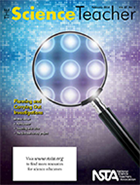Planning and carrying out investigations
By Mary Bigelow
Posted on 2014-02-14
 According to the editor, “Although the practice of planning and carrying out investigations has always been a part of good science instruction, the student focus often has been more on carrying out than on planning, with teacher-structured investigations far outnumbering student opportunities to develop their own research questions. Giving students opportunities to design and plan investigations allows them to truly experience the excitement of science and better understand the nature of scientific inquiry.”
According to the editor, “Although the practice of planning and carrying out investigations has always been a part of good science instruction, the student focus often has been more on carrying out than on planning, with teacher-structured investigations far outnumbering student opportunities to develop their own research questions. Giving students opportunities to design and plan investigations allows them to truly experience the excitement of science and better understand the nature of scientific inquiry.”
But this doesn’t mean that the teacher says “Do an investigation” and wait for the students to come up with something. The featured articles in this issue show how teachers can provide background information and preliminary experiences so that students can “practice” real science.
For example, Pond Power refocuses a traditional activity to incorporate research on how algae could be a renewable alternative to fossil fuels. After an awareness activity in which students examine the algae species found in pondwater, they go on to investigate how to grow algae in the lab and design and then build photobioreactors. The article has suggestions for assessment and interdisciplinary connections. The extensive list of resources has rubrics and additional suggestions. [SciLinks: Algae]
Elementary and middle school students do activities with light bulbs and circuits. Teaching Electricity and Engineering With LEDs shows how to extend this with investigations using LEDs. I like how the authors describe “tinkering time”—time for students to practice critical thinking and brainstorming and how students can use their knowledge to design electronic devices. [SciLinks: Electric Circuits, Electric Current]
For a field biology class, The Bird Box Survey Project would be an authentic citizen science project. The data collected by the students could be used in a variety of investigations on bird behavior. If your school is not near a nature center or outdoor facility, you can still conduct ongoing investigations—see the SciStarter site for ideas.
The author of Can You Picture That? shares a 5e lesson on how to design and conduct an investigation to test the validity of popular claims. Given a statement such as “Touching a toad will give you warts” or “Listening to classical music increases SAT scores,” students working in teams design a strategy to test the statement. The twist is that they are not allowed to use words to explain their design—only pictures (think of the game Pictionary). Their focus is on the process, not vocabulary such as constant or independent variable (these can be introduced later). The article includes examples of student work and suggestions for implementation. I could see students really enjoying this!
Two other articles describe projects that could be done as student research. Get Grounded in Groundwater has resources for students to investigate their own local water sources. Although The Missing Piece: Classroom-Based Exercise is addressed to teachers, students could design a study of the effectiveness of exercise in class: what kind, how often, how much? Or it could be an interesting action research project for teachers. [SciLinks: Groundwater, Aerobic and Anaerobic Exercise]
Disclaimer: The views expressed in this blog post are those of the author(s) and do not necessarily reflect the official position of the National Science Teaching Association (NSTA).

